|
We decided to test the theories presented by Dr. Bowker and Mr. Ovnicek. We took six horses of which we knew the history and used them in our informal trials. Each horse had a particular problem which we were well accustomed to and we hoped to see what transpired after application of four point trims or natural balance shoeing.
Two horses were typically shod. One was a half Clydesdale mare who tends to move heavy on the front end and the other is an aged appaloosa gelding who is a recovered founder horse (had rotated front coffin bones which are now back in alignment.) The horse is mildly arthritic and has a tendency to stumble.
The horses are kept in sand pastures or paddocks and the winters in this region were typically rainy with wet ground present from November through May, with the ground hardening occasionally in late spring as the rains became less frequent. Summers are totally arid until early November.
The intent of this experiment was to see if natural balance shoeing would encourage normal hoof development and we would follow the progress of these horses and see if the problem symptoms diminished over the 1998 season. They were shod on January 28, 1998. This document will be updated as time goes on and we have something to report.
|
The first image we would like to show is one which displays the difference in shape of the Natural Balance Shoe and an ordinary aluminum web shoe. The purpose of the
blunt toe in the Natural Balance Shoe is to place the point of breakover within 1 1/8 to 1 1/4" forward of the apex of the frog.
|

|
|
The foot is prepared much the same way as it would be if a conventional shoe was applied. The shoe is shaped and fit to the sole. Not much shaping is required and the shoe tends to want to position itself at the appropriate location on the foot.
This shoe is a lot like a forged rocker toe shoe. It has some minor differences including some interior edges which are designed to hold mud against the sole. Also, this shoe can provide the advantages of rockers for those horse owners who shoe themselves or whose farriers don't hot shoe.
|
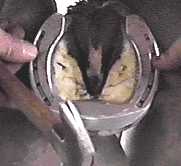
|
In the view below, you can make out the toe extending slightly past the front of the shoe. The shoe has a natural rocker cast into it and the toe is rasped so as to continue the plane of the rockered shoe. The nail holes match up to the stock aluminum shoe which is pictured at the top of this page.
|
The photo on the near right is the Natural Balance Shoe and the photo on the far right is a keg on the same horse onto which a rocker toe was forged. While the photographic angles are slightly misleading, the rockered keg is similar to the Natural Balance Shoe except that the keg's point of breakover is about 1/4" farther forward than the NBS.
|
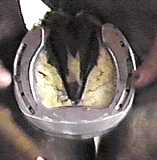
|
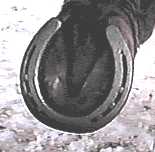
|
|
Here are some views of both shoes. Please note that the rockered keg is shown on 8 weeks of growth while the NBS is on a freshly prepared foot The horse is now wearing a pair of Natural Balance Shoes and we will see how he moves in them as weather permits.
|
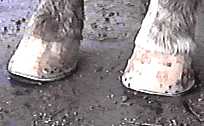
|
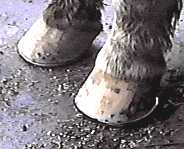
|
|